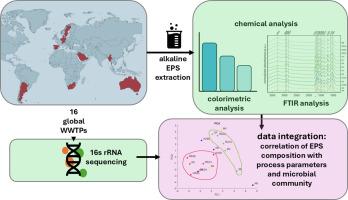Global insights into extracellular polymeric substances from activated sludge: Yield, composition, and microbial communities
IF 12.4
1区 环境科学与生态学
Q1 ENGINEERING, ENVIRONMENTAL
引用次数: 0
Abstract
Activated sludge (AS) wastewater treatment generates substantial excess sludge which needs to be discarded and thereby increasing operational costs. Extracellular polymeric substances (EPS) within AS present a potential resource for recovery, reducing sludge volume and mass while adding value. Achieving this goal requires a better characterization of EPS, as the relationship between its composition and the microbial communities responsible for its production remains insufficiently understood. Here, we analysed extracted EPS from 16 wastewater treatment plants across 13 countries and 5 continents and found that alkaline extractable EPS yields varied widely (2.81–18.5 wt.% VSS). The microbial community composition of abundant species varied across plants and particularly across continents and did not correlate to the EPS yield. Only sludge retention time had a significant correlation with the EPS yield (p < 0.005). Traditional colorimetric assays failed to detect compositional trends of the EPS, but Fourier Transform Infrared (FTIR) analysis indicated that extracted EPS from biological phosphorus removal systems had higher lipid and polysaccharide content, while chemical phosphorus removal systems had higher relative protein content. Thus, FTIR proved effective for distinguishing extracted EPS composition, demonstrating its potential as a high-throughput characterization tool. These findings highlighted that the wastewater treatment design and operation may shape the functional groups in EPS when using the alkaline method. More investigations are needed to find possible correlations between the composition of extracted EPS and the microbial community structure. Overall, the study presents a baseline for the amount and overall composition of biopolymers that can be extracted from global AS plants for recovery.

从活性污泥的胞外聚合物质的全球见解:产量,组成和微生物群落
活性污泥(AS)废水处理产生大量多余的污泥,需要丢弃,从而增加了运营成本。AS中的细胞外聚合物(EPS)是一种潜在的回收资源,可以减少污泥的体积和质量,同时增加价值。实现这一目标需要更好地表征EPS,因为其组成与负责其生产的微生物群落之间的关系仍然没有得到充分的了解。在这里,我们分析了来自13个国家和5大洲的16个污水处理厂提取的EPS,发现碱性可提取EPS的产率差异很大(2.81-18.5 wt.% VSS)。丰富物种的微生物群落组成在不同植物间存在差异,特别是在不同大陆间,并且与EPS产量无关。只有污泥滞留时间与EPS产率显著相关(p < 0.005)。传统的比色法无法检测EPS的组成趋势,但傅里叶变换红外(FTIR)分析表明,从生物除磷体系中提取的EPS具有较高的脂质和多糖含量,而化学除磷体系中提取的EPS具有较高的相对蛋白质含量。因此,FTIR被证明可以有效地区分提取的EPS成分,显示了其作为高通量表征工具的潜力。这些结果表明,废水处理设计和操作可能会影响碱性法EPS中官能团的形成。EPS的组成与微生物群落结构之间的关系有待进一步研究。总的来说,该研究为从全球AS植物中提取用于恢复的生物聚合物的数量和总体组成提供了基线。
本文章由计算机程序翻译,如有差异,请以英文原文为准。
求助全文
约1分钟内获得全文
求助全文
来源期刊

Water Research
环境科学-工程:环境
CiteScore
20.80
自引率
9.40%
发文量
1307
审稿时长
38 days
期刊介绍:
Water Research, along with its open access companion journal Water Research X, serves as a platform for publishing original research papers covering various aspects of the science and technology related to the anthropogenic water cycle, water quality, and its management worldwide. The audience targeted by the journal comprises biologists, chemical engineers, chemists, civil engineers, environmental engineers, limnologists, and microbiologists. The scope of the journal include:
•Treatment processes for water and wastewaters (municipal, agricultural, industrial, and on-site treatment), including resource recovery and residuals management;
•Urban hydrology including sewer systems, stormwater management, and green infrastructure;
•Drinking water treatment and distribution;
•Potable and non-potable water reuse;
•Sanitation, public health, and risk assessment;
•Anaerobic digestion, solid and hazardous waste management, including source characterization and the effects and control of leachates and gaseous emissions;
•Contaminants (chemical, microbial, anthropogenic particles such as nanoparticles or microplastics) and related water quality sensing, monitoring, fate, and assessment;
•Anthropogenic impacts on inland, tidal, coastal and urban waters, focusing on surface and ground waters, and point and non-point sources of pollution;
•Environmental restoration, linked to surface water, groundwater and groundwater remediation;
•Analysis of the interfaces between sediments and water, and between water and atmosphere, focusing specifically on anthropogenic impacts;
•Mathematical modelling, systems analysis, machine learning, and beneficial use of big data related to the anthropogenic water cycle;
•Socio-economic, policy, and regulations studies.
 求助内容:
求助内容: 应助结果提醒方式:
应助结果提醒方式:


